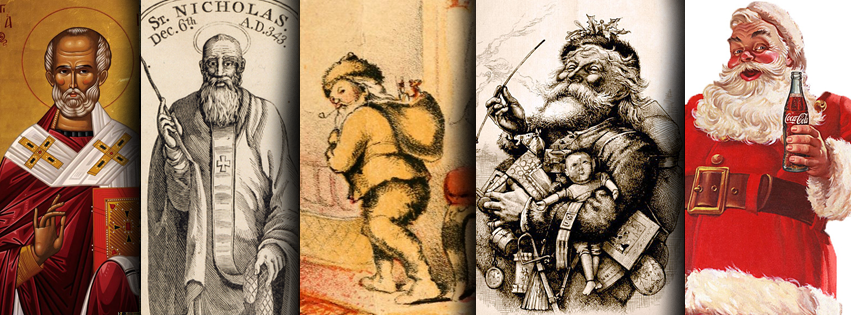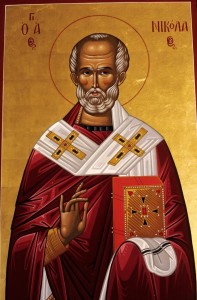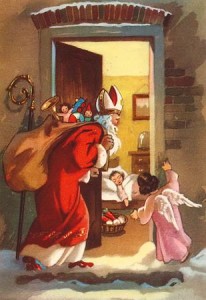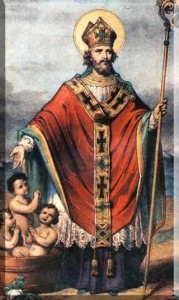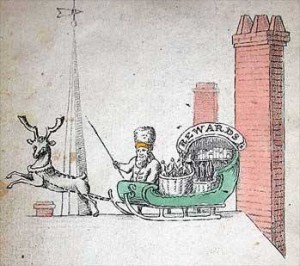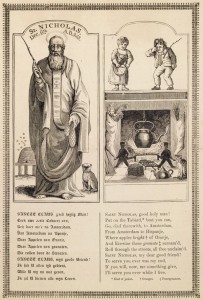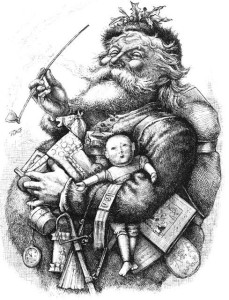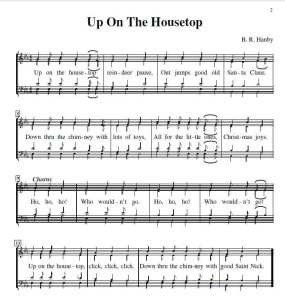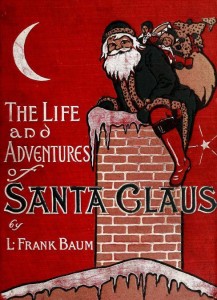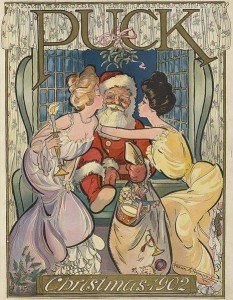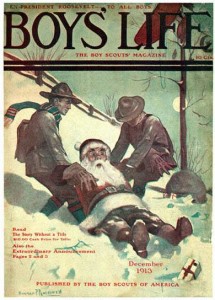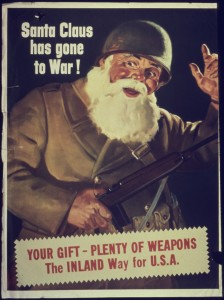A History of Santa Claus
The Santa Claus we know today wasn’t always a sleigh riding gift-giving jolly man in a red suit. His origins date back to a 4th century Greek saint. Here is a look at the history of Santa Claus over the centuries, the meaning behind the man, and how his image has been portrayed in art.
13th Century
Sint Nikolaas (Saint Nicholas) was the historic 4th century Greek saint with a reputation for secret gift giving. The Dutch pronunciation is Sinter Klaas, and is considered the basis for the North American figure of Santa Claus (which was brought by settlers to New York in the 17th century). Saint Nicholas was Nicholaas van Myra, born in what is present day Turkey on March 15, 270 AD and died at the age of 73 on December 6, 343 AD.
13th Century
St. Nicholas is the patron saint of children, and St. Nicholas Day is celebrated every December 6th (the anniversary of the death of Nicholaas van Myra). The traditional celebration consists of leaving gifts or coins in the shoes of children. St. Nicholas Day focuses on giving more than receiving, and tells the story of a Christian saint whose model life inspires compassion and charity.
In his Dutch form, St. Nicholas is believed to carry a staff, ride a white horse above the rooftops, and have helpers who listened at chimneys to find out if children were bad or good.
14th Century
The custom of hanging stockings by the fireplace came from St. Nicholas. When Nicholas was alive, he knew a poor man who had three daughters. Because he was so poor, the man did not have enough money for a dowry which meant his daughters could not get married. One night, Nicholas, who had inherited a large sum of money after losing his parents at a young age, dropped a bag filled with gold down the chimney for the man. The bag fell into a stocking that had been hung by the fire to dry. He did the same thing a second time. Legend says that the father secretly hid by the fire every evening, determined to find out who was giving him the money. He discovered it was Nicholas, and when he thanked him, it’s said that Nicholas told him he only had God to thank for gold. Nicholas became known for giving generously and humbly to those in need throughout his life.
St. Nicholas providing dowry money is the story behind his patronage for young women seeking a marriage partner. Today, young women wishing to get married travel to the Basilica di San Nicola in Bari in Italy on the 6th of December to leave a note to St. Nicholas and put three coins in a box.
15th Century
Other stories that connect Saint Nicholas to Santa Claus describe him as the protector of children. Several miracles attributed to Saint Nicholas involve rescuing children. As the Bishop of Myra, Nicholas traveled to an inn while in Athens. Upon arriving, his senses told him that the innkeeper had murdered 3 boys. After denouncing the innkeeper, it is said that Nicholas prayed and the boys were brought back to life. Another story involves the Saint rescuing a boy named Basilios and returning him to his family during a celebration of St. Nicholas Feast Day a year after he had been kidnapped by pirates.
17th Century
As the first Christian Roman Emperor, Constantine initiated the very first Christmas celebration on December 25, 336 AD, a time when Bishop Nicholas of Myra (who would later become the inspiration for the Santa Claus we know today) was still alive. Though Christmas as we know it didn’t gain universal popularity until the 19th century, the first personification of Christmas occurred in the 17th century in a carol that referred to a “Sire Christmas.” Josiah King’s “The Examination and Tryal of Father Christmas” was published in 1686, soon after Christmas had been reinstated as a holy day in England after being banned as a symbol of “Catholic superstition and godless self-indulgence.” At the time, Father Christmas was a traditional figure in English folklore. He was a bearded figure who represented the spirit of good cheer, though he was not at all associated with children or with bringing gifts.
1809
Following the Revolutionary War, the heavily Dutch influenced New York City experienced a surge of interest in Dutch customs. Among them was a renewed interest in St. Nicholas. In 1809, author Washington Irving wrote the satirical fiction “Knickerbocker’s History of New York”. In it, he described a jolly St. Nicholas character who flew in a sleigh pulled by a reindeer and delivered presents down chimneys. This was in contrast to the saintly image that had been portrayed up to this point. Irving’s new description of the saint quickly became well-known. The English settlers soon adopted the Dutch celebrations of St. Nicholas’ Day (December 6th) and gradually merged them with their existing tradition of celebrating Christmas on December 25th.
1810
In 1804, John Pintard founded the New York Historical Society. As an influential patriot and antiquarian, he named St. Nicholas patron saint of the Society, as well as the city. Six years later on December 6th, the Society hosted its first St. Nicholas dinner. Artist Alexander Anderson was commissioned to draw an image of St. Nicholas to be handed out during the dinner. The representation still shows St. Nicholas as a religious figure, but now it shows him leaving gifts in stockings and rewarding the children for being good. While the annual celebration of St. Nicholas Day never quite took off the way Pintard had hoped, Anderson’s image of “Sancte Claus” certainly did.
1823
It is believed that Washington Irving’s “Knickerbocker’s History of New York” from 1809 was the inspiration for the Clement Clarke Moore poem “A Visit from St. Nicholas” that was originally published in 1823. The poem is now more commonly known as “Twas the Night Before Christmas,” and was reprinted each holiday season in newspapers across America, becoming the first traditional art of Christmas replayed year after year.
1863
Thomas Nast, a political cartoonist in the 1860s and 1880s for Harper’s magazine, took the words from “A Visit from St. Nicholas” to create the first representation that we know today of a rotund Santa in 1863. This famous image was part of a large illustration titled “A Christmas Furlough.” Nast would later add details such as a workshop, a home at the North Pole, and a list of children being labeled naughty or nice to the legend in subsequent illustrations he created for the annual Christmas issue of the magazine.
Side note: Though well-known for this illustration, German-born Nast is considered “The Father of the American Cartoon” having spent much of his time during the 19th century creating satirical art critiquing slavery and crime.
1863
Cartoonist Thomas Nast created the donkey and the elephant as symbols for Democrats and Republicans in the United States, as well as the goateed Uncle Sam. And because of him, we have the modern Santa Claus. But he was a political cartoonist, and the first Christmas scene Nast created appeared in the January 3, 1863 issue of Harper’s Weekly. In it, Santa is shown entertaining Union troops by hanging the President of the Confederate States of America, Jefferson Davis, in effigy. Nast’s work in support of the Union cause was highly successful and well-received by President Lincoln who proclaimed “Thomas Nast has been our best recruiting sergeant. His emblematic cartoons have never failed to arouse enthusiasm and patriotism, and have always seemed to come just when these articles were getting scarce.”
1864
Santa hasn’t always worn a red suit. Early depictions of him showed him in a variety of colors such as blue and green. The 1864 edition of “A Visit from St. Nicholas” shows us a pipe smoking Santa dressed in yellow.
1864
Former church minister, Benjamin Hardy, was working as a singing school instructor in 1864 when he composed the song “Up On The Housetop” as a Christmas sing-a-long. This was the first song to claim Santa landed on the roof of homes to go down the chimney, and is believed to be inspired by the poem “A Visit from St. Nicholas.” It is known as the second-oldest secular Christmas song, and is considered the first Yuletide song to focus primarily on Santa Claus.
1897
In 1897, 8 year-old Virginia O’Hanlon sent a letter to The Sun, a prominent New York City newspaper at the time, asking if there really was a Santa Claus after her father, Dr. Philip O’Hanlon, declared “If you see it in The Sun, it’s so.” The newspaper’s editor, Francis Church, penned the famous response, giving him an opportunity to expand upon the simple question by discussing the philosophical issues behind the meaning of Santa Claus. For more than 100 years, this letter and the response have carried on. There have been movies, a tv series, and even as the theme in a holiday window display at Macy’s department store in Herald Square (NYC).
1902
Author L. Frank Baum not only introduced us to “The Wizard of Oz.” In 1902, he wrote the children’s book “The Life and Adventures of Santa Claus.” With illustrations by Mary Cowles Clark, this book expanded on the legend of Santa Claus, adding details to his story, and increasing his popularity. We see, however, from the original cover of the book that the famous red suit is not yet mandatory.
1902
This cover for the December 1902 issue of Puck magazine (the first successful humor magazine in the US) was created by Frank A. Nankivell, an Australian illustrator. It is believed that this is the very first time Santa is depicted in the way that has become the standard way of drawing Santa. This image, created over 100 years ago, is indistinguishable from the way we imagine Santa to look today.
1913
Throughout his career, artist Norman Rockwell was a key player in cementing Santa’s modern look. This December 1913 issue of the Boy Scouts magazine, Boys Life, is titled “Santa and Scouts in Snow,” and was painted by Rockwell at the age of 18 when he served as Art Director of the magazine. While Rockwell is well-known for depicting Santa Claus numerous times throughout his career, this was his very first Santa Claus cover. In it, Santa has had an accident, but is rescued by two Boy Scouts who happen to be on the scene, thereby saving Christmas.
1931
When looking for ways to increase sales of their product during winter, the Coca-Cola company hired commercial illustrator Haddon Sundblom to create a series of paintings of Santa Claus holding a Coca-Cola. For inspiration, Sundblom turned to the Clement Clark Moore’s 1822 poem “A Visit From St. Nicholas.” In the beginning, Sundblom painted the image of Santa using his friend Lou Prentiss, a retired salesman. ‘My Hat’s Off’ is the first of Sundblom’s Santas. It appeared in ads in December of 1931 as a reminder to people that they could drink Coke all year round. Coca-Cola continued to use Sundblom’s oil paintings of Santa in their advertising from 1931 until 1964. While Coca-Cola didn’t invent the modern day Santa, Sundblom’s paintings are believed to have strongly influenced the way other artists have depicted Santa ever since.
1942
After WWII came to the United States with the bombing of Pearl Harbor in 1941, Santa Claus was seen in posters produced by the War Production Board to help with the war effort. This image titled “Santa Claus Has Gone To War” from 1942 uses jolly St. Nick to support wartime efforts on the home front by urging Americans to buy war bonds, conserve resources and maintain silence to prevent leaks to the enemy. Following WWII, the American Santa Claus became a symbol of generosity as American troops dressed as Santa and gave food and toys to children in war-torn Europe.
Throughout the 20th century and into the 21st century, Santa continues to support our American military. Whether it be personal visits from Saint Nick to troops serving oversees or programs such as OP Santa Claus in Canada and “Send Santa to Our Troops” which include care packages sent to American service men and women during the holidays, we see Santa Claus is a symbol meant for more than just children. He takes care of us all.
2016
Eric Schmitt-Matzen has been a professional Santa in Knoxville, Tennessee for years. He has spent those years entertaining children and spreading Christmas spirit. With his authentic snow white beard, he looks the part of Santa in every way. Over the years, he’s listened as children put in requests for bikes and toys, but it was the request of a 5 year-old terminally ill child that showed us how much Santa Claus truly means to a child. He was asked to rush to an area hospital after the child had asked to see Santa. The child spoke with Santa briefly, spending his last moments looking at the face of the elf who has survived centuries. Santa exists. Kindness. Compassion. Love. Comfort. That’s the spirit of Santa Claus. So many times it takes the eyes of a child to see the world as we all should see it.
Over thousands of years, a saint known for his generosity to those in need has slowly evolved into the jolly elf we know today who lives at the North Pole and employs an army of elves and reindeer for a monumental 24 hour event held every year. Through the art of storytelling, the composition of songs, and the paint of a brush, the man we know as Santa Claus has become one of the most recognizable people in the world. And while we may believe with all our hearts in the magic of Santa Claus for only a short time in our lives, there’s no doubting that period in a child’s life is important in so many ways. For one, Santa represents hope, and the belief in something better. He has helped children for generations develop vibrant imaginations. He allows our children to imagine a brighter future, and helps them set goals to accomplish (e.g., to be good). As moms and dads witness the joy in the faces of their children throughout the holiday season, it’s hard not to be caught up in their excitement. It’s an important reminder to all of us every December. As the world around us becomes more and more chaotic, Santa Claus reminds us of the simple joy we receive when we give to others, and the feeling of good will that we feel during the holiday season for those around us. He’s much more than a gift giver. His legend has survived for thousands of years because when we believe in something we can not touch or feel, we free ourselves to believe in the power of love. Love for each other and for ourselves. Santa is happiness and hope. And who doesn’t need that?

